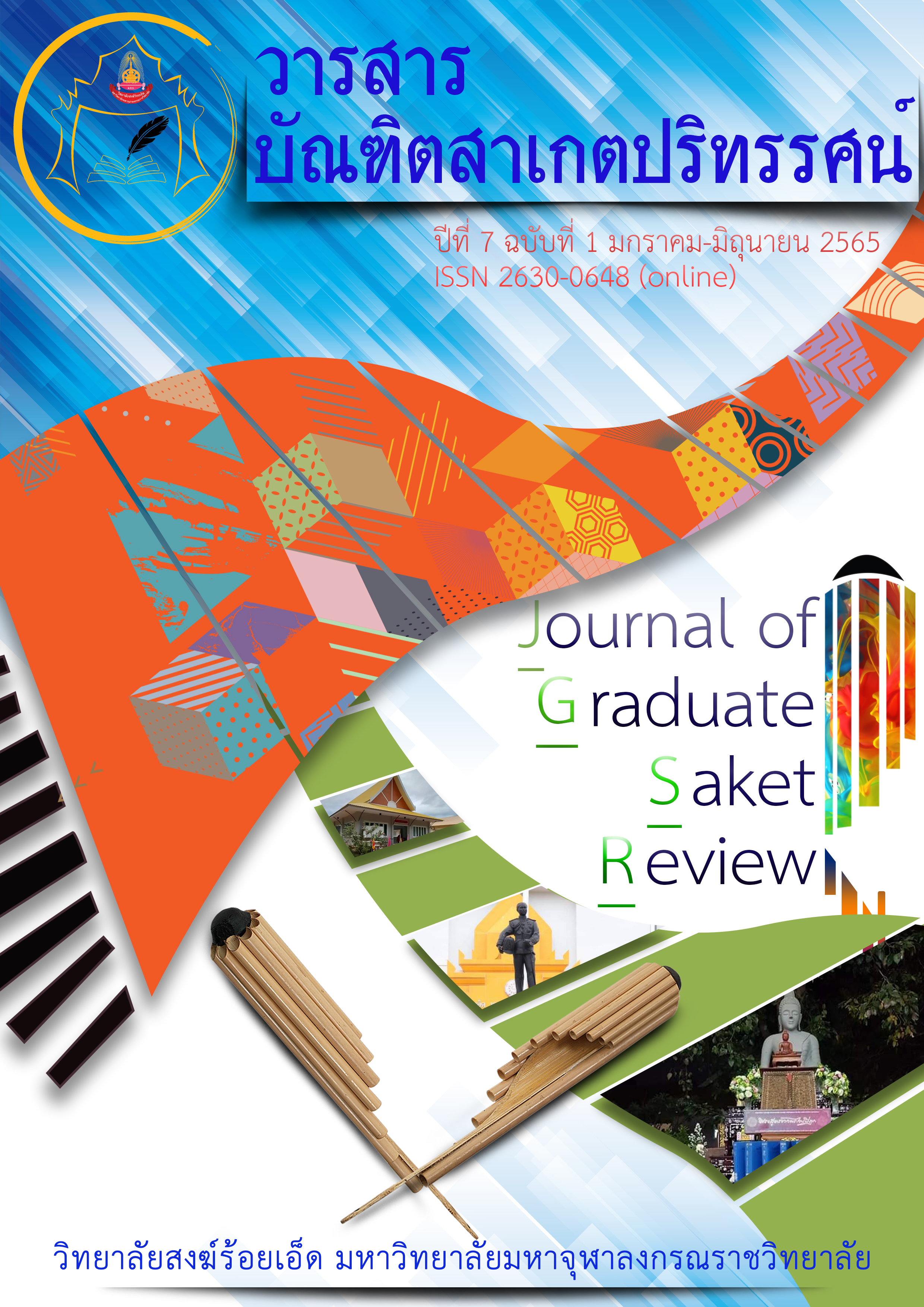The Four Noble Truths : Buddha’s Applicable Way Fostering Self-Directed Learning
Main Article Content
Abstract
Education in the digital age has changed upon the time, globalization era, in terms of both teachers and learners who rely on learning and teaching tools. The technological tools have been adjusted according to the paradigm shift based on ages, learning styles and nature of the subject so as to relate to knowledge distribution. Consequently, the ways of learning in this age have not been limited in not only the classroom, but also anytime and anywhere. As it is called “online learning” which meets the modern people’s lifestyles and learners’ various needs especially Generation Y and Z, its content and platform are flexible. Accordingly, it has built up life-long learning, self-directed learning as well as engaging learners’ critical thinking and problem-solving skills through intellectual strategy. The four noble truths are spiritually practical and applicable into everyday life, based on worthy Buddhist path consisting of suffering (Dukkha), origin of suffering (Samudāya), cessation of suffering (Nirodha) and path to the cessation of suffering (Magga).
Article Details

This work is licensed under a Creative Commons Attribution-NonCommercial-NoDerivatives 4.0 International License.
เนื้อหาและข้อมูลในบทความที่ลงตีพิมพ์ในวารสารบัณฑิตสาเกตปริทรรศน์ ถือเป็นข้อคิดเห็นและความรับผิดชอบของผู้เขียนบทความโดยตรงซึ่งกองบรรณาธิการวารสาร ไม่จำเป็นต้องเห็นด้วย หรือร่วมรับผิดชอบใด ๆบทความ ข้อมูล เนื้อหา รูปภาพ ฯลฯ ที่ได้รับการตีพิมพ์ในวารสารบัณฑิตสาเกตปริทรรศน์ ถือเป็นลิขสิทธิ์ของวารสารบัณฑิตสาเกตปริทรรศน์ หากบุคคลหรือหน่วยงานใดต้องการนำทั้งหมดหรือส่วนหนึ่งส่วนใดไปเผยแพร่ต่อหรือเพื่อกระทำการใด ๆ จะต้องได้รับอนุญาตเป็นลายลักอักษรจากวารสารบัณฑิตสาเกตปริทรรศน์ ก่อนเท่านั้น
References
กระทรวงศึกษาธิการ. (2545). พระราชบัญญัติการศึกษาแห่งชาติ พ.ศ. 2542 และที่แก้ไขเพิ่มเติม (ฉบับที่ 2) พ.ศ. 2545. กรุงเทพมหานคร: องค์การรับส่งสินค้าและพัสดุภัณฑ์.
ทิศนา แขมมณี. (2546). 14 วิธีสอนสำหรับครูมืออาชีพ. (พิมพ์ครั้งที่ 4). กรุงเทพมหานคร: จุฬาลงกรณ์มหาวิทยาลัย.
บีบีซีนิวส์. (2560). 10 พระราชดำรัสของรัชกาลที่ 10. สืบค้นเมื่อ 19 กรกฎาคม 2564, จาก https:// www.bbc.com/thai/.
พระธรรมปิฎก (ป.อ.ปยุตโต). (2544). พุทธวีธีในการสอน. (พิมพ์ครั้งที่ 4). กรุงเทพมหานคร: โรงพิมพ์บริษัทสหธรรมิก.
พระมหาประเสริฐ ชาตเมธี (โนไธสง) และคณะ. (2561). การใช้วิธีสอนแบบอริยสัจสี่ในสาระพระพุทธศาสนา นักเรียนขั้นประถมศึกษาปีที่ 6 โรงเรียนบ้านหลักร้อย จังหวัดนครราชสีมา. วารสารครุศาสตร์ปริทรรศน์. 5(1), 54-65.
ราชบัณฑิตยสถาน. (2551). พจนานุกรมฉบับเฉลิมพระเกียรติ. กรุงเทพมหานคร: นานมีบุ๊คส์พับลิเคชั่นส์.
รุ่งทิวา จักร์กร. (2521). วิธีสอนทั่วไป. ภาควิชาหลักสูตรและการสอน มหาวิทยาลัยศรีนครินทรวิโรฒประสานมิตร2521.
วิทย์ วิศเวทย์ และเสถียรพงษ์ วรรณปก. (2547). หนังสือเรียนสาระการเรียนรู้พื้นฐาน กลุ่มสาระการเรียนรู้สังคมศึกษา ศาสนา และวัฒนธรรม วิชาพระพุทธศาสนา. กรุงเทพมหานคร: อักษรเจริญทัศน์.
วิริยะ ฤาชัยพาณิชย์. (2558). การสอนแบบสร้างสรรค์เป็นฐาน. วารสารนวัตกรรมการเรียนรู้. 1(2), 23-37.
สุวิทย์ มูลคำ และอรทัย มูลคำ (2549). ก้าวเข้าลู่...สู่การเลื่อนวิทยฐานะ. กรุงเทพมหานคร: ห้างหุ้นส่วนจำกัด ภาพพิมพ์.
______. (2545). 20 วิธีการจัดการเรียนรู้ : เพื่อพัฒนาคุณธรรม จริยธรรม ค่านิยม และการเรียนรู้โดยการแสวงหาความรู้ด้วยตนเอง. (พิมพ์ครั้งที่ 2). กรุงเทพมหานคร: ห้างหุ้นส่วนจำกัด ภาพพิมพ์.
หทัยชนก ตระกูลจำลอง และสุธาทิพย์ งามนิล. (2561). ผลการสอนตามหลักอริยสัจ 4 ที่มีต่อความสามารถในการคิดแก้ปัญหาและผลสัมฤทธิ์ทางการเรียนวิชางานธุรกิจของนักเรียนชั้นมัธยมศึกษาปีที่ 1. การประชุมวิชาการระดับชาติ ครั้งที่ 2 ด้านนวัตกรรมเพื่อการเรียนรู้ และสิ่งประดิษฐ์ ประจำปี 2561. 18 กรกฎาคม 2561.
อัญไอริณทร์ ราชวงศ์ และคณะ. (2558). ผลการจัดการเรียนรู้ สาระการเรียนรู้ ศาสนา ศีลธรรม จริยธรรม ตามวิธีสอนแบบอริยสัจสี่ สำหรับนักเรียนชั้นมัธยมศึกษาปีที่ 3. วารสารบัณฑิตศึกษา มหาวิทยาลัยราชภัฏเชียงราย. 8(17), 148-156.
Arthur, M. N. (2006). Solving life’s problems: A 5-step guide to enhanced well-being. Retrieved July 19, 2021, from https://www.anxietycanada.com/sites/default/files/Problem Solving.pdf.
Dowd, E. (2017). Skills for today: Digital literacy and the importance of the 4cs in a global context. Retrieved July 19, 2021, from http://www.p21.org/news-events/ p21blog/2172-digital-literacy-a-the-importance-of-the-4-cs-in-a-global-context.
Hiemstra, R. & Brockett, RG. (1994). From Behaviorism to Humanism: Incorporation Self-direction in Learning Concepts into the Instruction Design Process. In H.B. Long and Associates (Eds.). New Ideas about Self-directed Learning. Oklahoma: Research Center for Continuing Professional and Higher Education of the University of Oklahoma.
Knowles, M. (1975). Self-directed Learning: A guide for learners and teachers. Chicago: Association Press.


